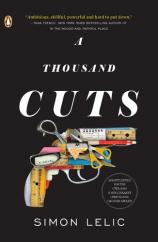A Thousand Cuts
Review
A Thousand Cuts
A THOUSAND CUTS, Simon Lelic’s debut novel now available in paperback, is difficult to classify in a particular genre. At its heart it concerns a mass murder, but is hardly a mystery, given that the killings take place at a British school in front of the faculty and student body. There is no question as to who the killer is; he is a history teacher, an odd duck named Sam “call me Samuel” Szajkowski, who is an extremely square peg unable to fit into the round hole of the school at which he has been hired, not only with the students but also with the faculty. It should be an easy investigation for Detective Inspector Lucia May, one for which a quickly prepared report should be a foregone conclusion, especially considering that Szajkowski was, with three students and a faculty member, his own last victim, thus sparing the people the cost of trial and imprisonment.
You can almost hear Lelic, in the back of May’s mind, whispering “not so fast.” But May, for reasons that soon come to light, becomes consumed with the “why” of Szajkowski’s actions, thus transforming A THOUSAND CUTS from a mystery into a psychological study, one that is at times uncomfortable but always intriguing.
Lelic is a former journalist, a background that he puts to good use in the book’s narrative. While a plurality of the novel is told from May’s perspective, a good part of it is made up of the first-person narratives of teachers, administrators and parents, so that readers are given the opportunity to obtain their own perspective of story elements. There is nothing particularly earth-shaking in these accounts --- anyone who has been the odd one out, witnessed the social pecking order either in a classroom or work setting, or, for that matter, among birds or wild dogs, will be familiar with what goes on.
But the chilling indifference with which such behavior is greeted by the people populating the institutions that supposedly police it stands out in sharp relief --- so sharply, in fact, that May will not let it go, despite being all but ordered to do so by her commanding officer. One major reason is that May herself is subjected to a horrendous amount of harassment in her workplace, on a level perhaps equaled to that which Szajkowski experienced. As May’s investigation into the events uncovers not only what led to Szajkowski’s actions but another act of brutality and tragedy as well, readers watch as the actions against May escalate. Obviously, things cannot continue for May as they have. What will she do? And will she also resort to violence of a sort? Surely she seems capable of it. The answer is found in the final few pages, where an accounting of all parties takes place. Of sorts.
A THOUSAND CUTS raises interesting issues, many of which were brought up some five decades ago when I was in school and were explored in some of the works of Charles Dickens. Any number of solutions have been proposed over the years --- my own experience has been that nothing fights fire like good return fire --- and, indeed, the book proposes one as well. Its strongest element, however, is the telling of the tale, which by switching narrative viewpoints recalls such works as Lawrence Durrell’s Alexandria Quartet, though in an entirely different setting. More is expected from Lelic later this year; a second novel, THE FACILITY, is due in the summer and promises to be an entirely different type of work from his debut. On its own, A THOUSAND CUTS demonstrates the depth of Lelic’s talent.
Reviewed by Joe Hartlaub on March 28, 2011
A Thousand Cuts
- Publication Date: January 25, 2011
- Genres: Fiction
- Paperback: 304 pages
- Publisher: Penguin (Non-Classics)
- ISBN-10: 0143118617
- ISBN-13: 9780143118619





